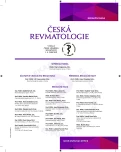Subcutaneous and elbow joint infection with Scedosporium apiospermum in a patient with rheumatoid arthritis
Authors:
T. Soukup 1; V. Buchta 2; R. Kříž Záňová 1; T. Veleta 3; M. Tošovský 1; P. Bradna 1
Authors‘ workplace:
Univerzita Karlova v Praze, Lékařská fakulta a Fakultní nemocnice v Hradci Králové, II. interní gastroenterologická klinika
1; Univerzita Karlova v Praze, Lékařská fakulta a Fakultní nemocnice v Hradci Králové, Ústav klinické mikrobiologie
2; Fakultní nemocnice Hradec Králové, Oddělení urgentní medicíny
3
Published in:
Čes. Revmatol., 23, 2015, No. 2, p. 69-75.
Category:
Case Report
Overview
Rheumatoid arthritis (RA) is a chronic inflammatory systemic disease, which in its essence and treatment leads to a higher incidence of infections. We describe a rare case of a 63-year-old male patient with many years of history of RA (treated with corticosteroids and conventional synthetic disease-modifying antirheumatic drugs), who developed subcutaneous and joint infection caused by fungus Scedosporium apiospermum (perfect stage Pseudallescheria boydii) after fifteen years of RA. Fungal agent from indolent subcutaneous lesions on his left forearm and right arm was found on microscopic and microbiological examination. The patient subsequently underwent a six-month cyclical treatment with voriconazole, which was alternated several times with itraconazole and terbinafine. After several cycles of six-month treatment, usually after about a year, a relapse occurred with repeated manifestation in the subcutaneous tissue and finally percontinuitatem even in the joint. After seven years of repeated outbreaks of fungal infection the patient dies of a sudden death with a clinical picture of thromboembolic disease. Autopsy results did not show active infection or overt infectious focus. Scedosporium apiospermum is fibrous, saprophytic fungus with relatively low virulence that is ubiquitously present in the environment, including soil and aquatic ecosystems. It is one of the typical causes of subcutaneous mycoses, the presence of which is largely tied to the subtropical region. In case of an immunosuppressed patient, infection by S. apiospermum may develop into severe systemic infection. Clinical observation completes the set of possible infectious complications in patients with RA.
Key words:
Rheumatoid arthritis, subcutaneous infection, Scedosporium apiospermum, voriconazole
Sources
1. Doran MF, Crowson CS, Pond GR, O'Fallon WM, Gabriel SE. Predictors of infection in rheumatoid arthritis. Arthritis Rheum. 2002; 46 : 2294–300.
2. Hughes LB, Criswell LA, Beasley TM, et al. Genetic risk factors for infection in patients with early rheumatoid arthritis. Genes Immun. 2004; 5 : 641–7.
3. Arnett FC, Edworthy SM, Bloch DA, et al. The American Rheumatism Association 1987 revised criteria for the classification of rheumatoid arthritis. Arthritis Rheum. 1988; 31 : 315–24.
4. Cortez KJ, Roilides E, Quiroz-Telles, F, et al. Infections Caused by Scedosporium spp. Clin Microbiol Rev 2008; 21 : 157–97. doi:10.1128/CMR.00039-07. PMID 18202441.
5. Dolin J, edited by Gerald LM, Bennett JE. Mandell, Douglas, and Bennett's principles and practice of infectious diseases. 5th ed.. Philadelphia: Churchill Livingstone; 2000.
6. Sedláček P. Terapie invazivních mykotických infekcí u imunosuprimovaných pacientů. Onkologie 2008; 2 : 186–90.
7. Ender PT, Dolan MJ. (1997). Pneumonia Associated with Near-Drowning. Clin Infect Dis. 1997; 25 : 896–907. doi:10.1086/515532. PMID 9356805.
8. Prober J, editor, Long S, Charles G, associate editors. Principles and practice of pediatric infectious disease. 4th ed. Edinburgh: Elsevier/Saunders; 2012.
9. de Hoog, GS, Guarro J, Gené J, Figueras MJ. Atlas of Clinical Fungi. 2nd ed. American Society for Mikrobiology; 2000.
10. Kusne S, Ariyanayanagam-Baksh S, Strollo DC, Abernethy J. Invasive Scedosporium apiospermum infection in a heart transplant recipient presenting with multiple skin nodules and a pulmonary consolidation. Transplant Infect Dis 2000; 2 : 194–6.
11. Liu YF, Zhao XD, Ma CL, Li CX, Zhang TS, Liao WJ. Cutaneous infection by Scedosporium apiospermum and its successful treatment with itraconazole. Clin Exp Dermatos 1997; 22 : 198–200.
12. Chaveiro MA, Vieira R, Cardoso J, Afonso A. Cutaneous infection due to Scedosporium apiospermum in an immunosuppressed patient. J Eur Acad Dermatol Venereol 2003; 17 : 47–9.
13. Uenotsuchi T, Moroi Y, Urabe K, et al. Cutaneous Scedosporium apiospermum infection in an immunocompromised patient and a review of the literature. Acta Derm Venereol 2005; 85 : 156-9.
14. Fays S, Di Cesare MP, Antunes A, Truchetlet F. Cutaneous and osteoarticular Scedosporium infection. Ann Med Interne 2002; 153 : 537–9.
15. Chaveiro MA, Vieira R, Cardoso J, Afonso A. Cutaneous infection due to Scedosporium apiospermum in an immunosuppressed patient. J Eur Acad Dermatol Venereol 2003; 17 : 47-9.
16. Ginter G, Petuschnig B, Pierer G, Soyer HP, Reischle S, Kern T, et al. Case report. Atypical cutaneous pseudallescheriosis refractory to antifungal agents. Mycoses 1999; 42 : 507–11.
17. Gottesman-Yekutieli T, Shwartz O, Edelman A, Hendel D, Dan M. Pseudallescheria boydii infection of a prosthetic hip joint--an uncommon infection in a rare location. Am J Med Sci. 2011; 342 : 250–3. doi: 10.1097/MAJ.0b013e31821f9691.
18. Kalkan Akçay E, Açıkgöz ZC, Can ME, Celikbilek N, Dereli Can G, Cağıl N. Fungal keratitis caused by Scedosporium apiospermum: first report from Turkey. Mikrobiyol Bul. 2013; 47 : 727–33.
19. Ajello L, Hay RJ. Topley & Wilson's Microbiology and Infectious Medical Mycology Vol 4. 9th ed. London: Arnold; 1997.
Labels
Dermatology & STDs Paediatric rheumatology RheumatologyArticle was published in
Czech Rheumatology

2015 Issue 2
Most read in this issue
-
Management of proximal femoral fracture patiens and secondary prevention of fractures.
II. Secondary antiosteoporotic care.
Position Paper of the Czech Rheumatology Society, the Czech Society for Metabolic Bone Diseases, and Czech Society for Orthopedics and Traumatology - Subcutaneous and elbow joint infection with Scedosporium apiospermum in a patient with rheumatoid arthritis
- Experimental models of systemic sclerosis – a tool to understand and treat an incurable disease?
